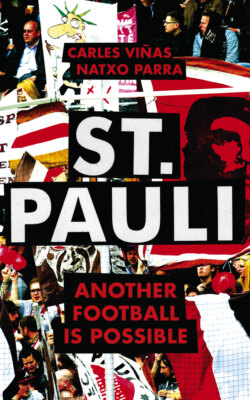Читать книгу St. Pauli - Carles Vinas - Страница 10
Preface
ОглавлениеThe iconic image of a black T-shirt with printed skull and crossbones is no longer unusual. Instead it has become part of our everyday surroundings, our common landscape, and our cities, towns and neighbourhoods. In the street or on the underground, at a concert or in any bar, it is less and less surprising to see young (and not so young) people wearing the Jolly Roger. Whatever differences there may be, the Sankt Pauli skull and crossbones seems to be following the footsteps of earlier icons such as the famous Ramones logo that became co-opted by large fashion chains.
Wearing the Jolly Roger above the words ‘ST. PAULI’ may have commercial implications (which of course we shall analyse). Yet it is really about taking a stance: one of political and social rebelliousness. We should forewarn that the history of Sankt Pauli is not an idyllic one. As with all great experiences it has fought tirelessly against its own contradictions and defects, in a world dominated by power and not love. It might not be the earthly paradise desired by those of us who love football but have an alternative vision for the sport based on the principle of radical solidarity. Yet undeniably St. Pauli is a magnificent starting point.
In order to understand the St. Pauli phenomenon, defend it and imagine it, you need to know the history of the club and the neighbourhood and city hosting it. Football clubs are not static entities; they evolve, and St. Pauli is no exception to that. Its history is one of vitality, commitment and rootedness. And it is one that fluctuates from providing football for the well-to-do to being a sport for the working classes; from being a select activity to a community one.
The book begins with the emergence of football in Germany – in Hamburg in particular, focusing on Sankt Pauli’s creation and first years of life. Then we look at the effect on the club of the rise of Nazism and the Second World War. This dark era must not be glossed over. Indeed, only by examining it is it possible to understand the club’s subsequent evolution: Sankt Pauli’s journey to becoming a cult club. This is the basis of its international image as a rebellious and alternative club that prides itself on its antifascism, antiracism and opposition to homophobia, sexism and all forms of discrimination, as is now stated in the club’s statutes.
We thought it appropriate to take the history of St. Pauli up to the present day. While chronicling it, we emphasise the club’s structure and its link with other spheres (whether its local vicinity, music scenes or movements to defend minorities), as well as the present-day challenges it is tackling. In all, we explain how a club’s supporters have empowered themselves and been able to influence the decision making of a professional football club.
This book provides a political and social contextualisation to St. Pauli. Only through this can we comprehend its meaning today and how it has won the heart of many and the sympathy of millions: a club that has no problem with adopting political stances or openly proclaiming itself antifascist. The book is our humble contribution to those who love football as a social activity – of solidarity and communalism – but who reject the business that capitalism has turned this sport into. In fact, paraphrasing Eduardo Galeano3 while receiving the Manuel Vázquez Montalbán International Journalism Award, we wrote these pages because ‘we think the best way to be on the left wing is defending the freedom of those brave enough to play for the pleasure of doing so in a world that tells you to play with the duty of winning’.
_______________
3. [Translator’s note]: Uruguayan writer and journalist, author of the acclaimed Open Veins of Latin America and Soccer in Sun and Shadow.
